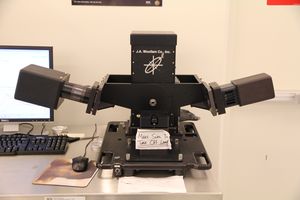Difference between revisions of "Ellipsometer (Woollam)"
Jump to navigation
Jump to search
| (2 intermediate revisions by the same user not shown) | |||
| Line 29: | Line 29: | ||
== Operating Procedures == |
== Operating Procedures == |
||
| − | *[[media:|Operation procedures for the JA Woollam Ellipsometer]] |
+ | *[[media:Operation_Manual_of_JA_Woollam_Ellipsometer-a.pdf|Operation procedures for the JA Woollam Ellipsometer]] |
**Includes examples of fitting various films, fitting parameters and useful program options. |
**Includes examples of fitting various films, fitting parameters and useful program options. |
||
| + | *[[media:CompleteEASE_Manual.pdf|CompleteEASE Software Manual]] |
||
*Contact us for help fitting difficult films (such as very thin metals etc.) |
*Contact us for help fitting difficult films (such as very thin metals etc.) |
||
Revision as of 14:41, 9 September 2019
|
About
The Woolam M-2000DI Variable Angle Spectroscopic Ellipsometer is used for the general characterization of optical thin films using ellipsometry.
This tool incorporates a wavelength range from 193nm up to 1650nm and a motorized variable angle control from 45 degrees to 90 degrees in order to provide the widest flexibility for characterization of optical (and some electrical) properties of thin films. The CompletEASE software makes measurement taking and simple analysis very straightforward and provides for complex multi-layer and absorbing film analysis as well. All data is saved for each film so that post-measurement analysis can be performed. This system is also in-situ capable for the ALD system in the facility.
Specifications
- Film Thickness Range: about 0.5nm to ~10-15µm. (Both of these extremes are difficult but can be measured with some effort.)
- Refractive Index (n) / Absorption (k)
- Wavelength range: 193–1650nm (Deuterium + Quartz-Tungsten Halogen Lamps)
- Angles: 45° – 90°
- Models for many materials available, including general-purpose models such as:
- Cauchy (n) with Urbach absorption (k),
- Sellmeier (n),
- B-Spline/Lorentz/Drude for absorbing/metallic films
- General Oscillator for complex refractive index/absorption
- Many "Tabulated" models, where the RIx & Absorption are fixed (not fit), so only Thickness is fit.
Operating Procedures
- Operation procedures for the JA Woollam Ellipsometer
- Includes examples of fitting various films, fitting parameters and useful program options.
- CompleteEASE Software Manual
- Contact us for help fitting difficult films (such as very thin metals etc.)
